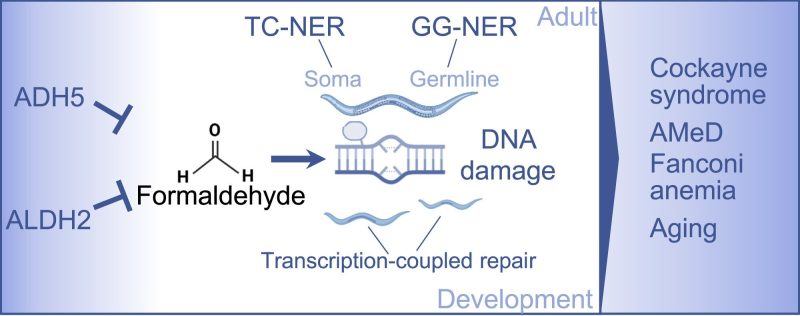Researchers uncover how cells deal with formaldehyde toxicity during growth and aging

AMeD syndrome is a severe genetic condition found in children that presents with accelerated aging, global developmental delay and bone marrow failure, progressing to myelodysplastic syndrome and acute myeloid leukemia.
It is caused by mutations in the ADH5 and ALDH2 genes, which are responsible for the transformation of formaldehyde, a known environmental hazard, into less toxic compounds. In AMeD patients, however, formaldehyde accumulates within the cells and attacks the cellular components, overwhelming the repair machinery.
Formaldehyde is a quite simple yet reactive organic compound that can be found in building materials, household products, cigarette smoke, and vehicle emissions. However, it is more than just an environmental hazard, since formaldehyde can also be produced within your cells as a by-product of your own metabolism.
Indeed, during normal growth your cells produce this reactive toxin that may cause trouble if not properly detoxified. The good news is that your cells have a plethora of repair systems built-in that avoid or correct most of the damage caused by formaldehyde.
For a long time, researchers have wondered which of the detoxification and repair systems are the most relevant to counteract formaldehyde toxicity, especially considering it can act over many different cellular components, producing a great diversity of damage that requires largely different repair tools. Nevertheless, finding the right in vivo model has proven difficult up until now.
Recent work led by the teams of Prof. Bjoern Schumacher at the University of Cologne, Germany, and of Dr. Lucas Pontel from the Josep Carreras Leukemia Research Institute, reported the development of a genetically tractable animal model of AMeD.
The study, published in Nucleic Acid Research, used the roundworm C. elegans and patient-derived human cells to resolve which are the key mechanisms that protect the genome from formaldehyde during development, adulthood and aging.
The researchers identified at least three distinct mechanisms that address formaldehyde-induced DNA damage. First, in the germline and early embryonic development, the preferred repair mechanism is the global genome nucleotide excision repair, a system capable of repairing the DNA in bulk, frequently used to protect cells from UV radiation.
The second, in adults and non-dividing cells, where DNA is not being replicated, formaldehyde toxicity is counteracted by the canonical transcription-coupled repair, which normally deals with DNA lesions in coding genes that are actively being transcribed.
The third occurs during development, when cells are dividing. The preferred mechanism is a branch of the transcription-coupled repair system operating independently of the canonical nucleotide excision repair, a system used to resolve DNA-protein crosslinks.
The identification of the key repair mechanisms for formaldehyde-induced damage is a valuable piece of information. However, the team of researchers went beyond and found that the known antioxidant and formaldehyde quencher N-acetyl-L-cysteine (NAC) could reverse most of the toxicity in the animal model of AMeD and in human cells with alterations in the DNA repair systems, offering an unexpected clue for a potential therapeutic intervention to revert formaldehyde-pathogenic consequences.
While this research is still in the preclinical stage, the researchers are confident that it can inspire new therapeutic and dietary interventions to reduce the toxicity of this metabolic toxin, not only for AMeD patients, but also for individuals with a familial history of cancer development.
More information:
Matthias Rieckher et al, Distinct DNA repair mechanisms prevent formaldehyde toxicity during development, reproduction and aging, Nucleic Acids Research (2024). DOI: 10.1093/nar/gkae519
Citation:
Researchers uncover how cells deal with formaldehyde toxicity during growth and aging (2024, September 12)
retrieved 13 September 2024
from https://medicalxpress.com/news/2024-09-uncover-cells-formaldehyde-toxicity-growth.html
This document is subject to copyright. Apart from any fair dealing for the purpose of private study or research, no
part may be reproduced without the written permission. The content is provided for information purposes only.








